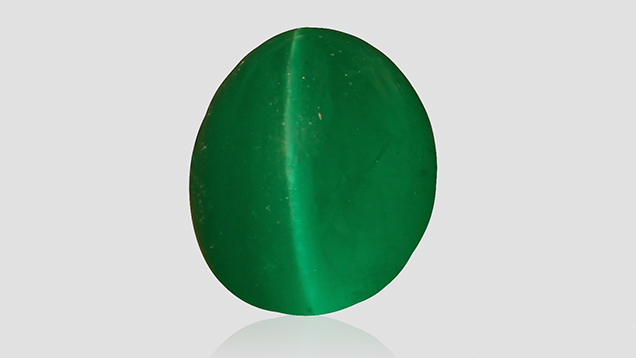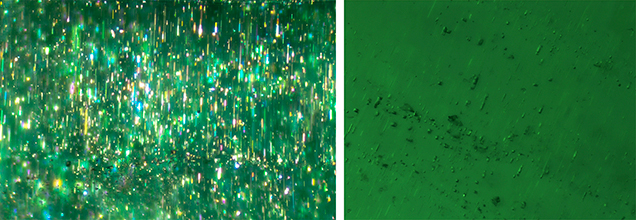Large Cat’s-Eye Emerald from Brazil


Figure 2. Multiphase inclusions of different shapes and sizes, seen in reflected light (left) and brightfield illumination (right), gave rise to the cat’s-eye effect in the Brazilian emerald. Photomicrographs by Wenxing Xu (left) and Stefanos Karampelas (right). Image width 2 mm (left) and 1.2 mm (right).
The UV-Vis absorption spectra showed the characteristic Cr3+- as well as Fe2+- and Fe3+- related bands. In the FTIR absorption spectra, type I and type II water molecules were observed. An intense band at around 2360 cm–1 indicated the presence of CO2, most likely in the multiphase inclusions. Trace-element analysis of the sample with laser ablation–inductively coupled plasma–mass spectrometry (LA-ICP-MS) showed contents consistent with schist- and pegmatite-related emeralds. It also showed lower Li, Cs, and Rb than in emeralds related to highly evolved pegmatites, such as those from Sandawana (Zimbabwe) and Kafubu (Zambia); see J.C. Zwaan et al., “Emeralds from the Fazenda Bonfim region, Rio Grande do Norte, Brazil,” Spring 2012 G&G, pp. 2–17. The stone’s composition was consistent with emeralds from Itabira–Nova Era, Minas Gerais, based on GGL’s reference collection and the published literature on the pegmatites of the area (C. Preinfalk et al., “The pegmatites of the Nova Era–Itabira–Ferros pegmatite district and the emerald mineralisation of Capoeirana and Belmont (Minas Gerais, Brazil): geochemistry and Rb-Sr dating,” Journal of South American Sciences, Vol. 14, No. 8, 2002, pp. 867–887). This exceptional stone is one of the largest Brazilian cat’s-eye emeralds examined by GGL to date.



